| |
|
|
39.
| Oriental Accident |
| |

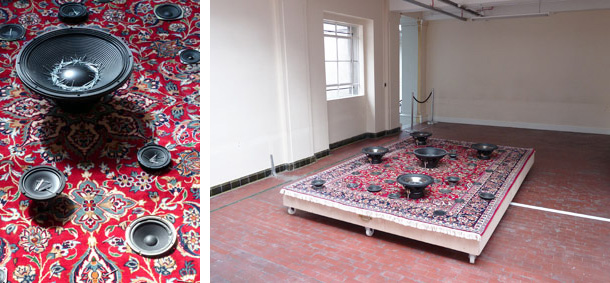
2011, 50cm x 336cm x 226cm, sound system, speakers carpets on a wooden structure.
Exhibition view of Terrible Beauty, Dublin Contemporary 2011, Dublin.
Courtesy of the artist and Jane Lombard, New York.
Ed. of 5 + 1 A.P.
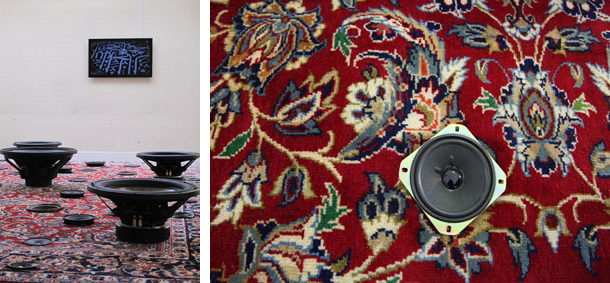
2011, 50cm x 336cm x 226cm, sound system, speakers carpets on a wooden structure.
Exhibition view of Terrible Beauty, Dublin Contemporary 2011, Dublin.
Courtesy of the artist and Jane Lombard, New York.
Ed. of 5 + 1 A.P.
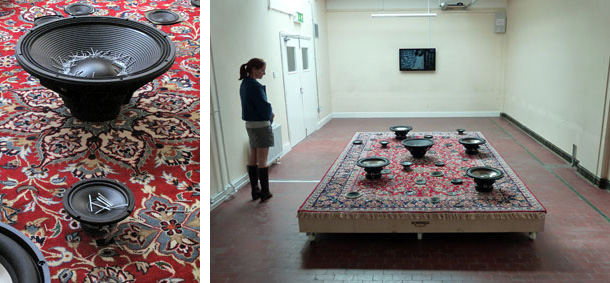
2011, 50cm x 336cm x 226cm, sound system, speakers carpets on a wooden structure.
Exhibition view of Terrible Beauty, Dublin Contemporary 2011, Dublin.
Courtesy of the artist and Jane Lombard, New York.
Ed. of 5 + 1 A.P.
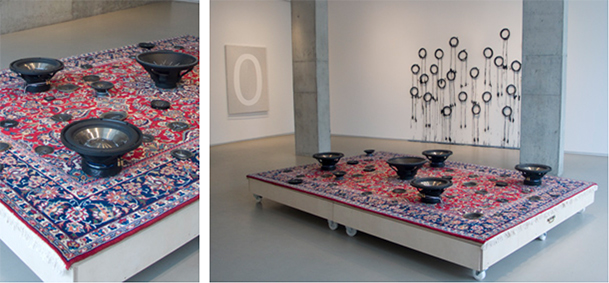
2011, 50cm x 336cm x 226cm, sound system, speakers carpets on a wooden structure.
Exhibition view of Oriental Accident, Lombard-Freid Projects, 2012, New York.
Courtesy of the artist and Jane Lombard, New York.
Ed. of 5 + 1 A.P.
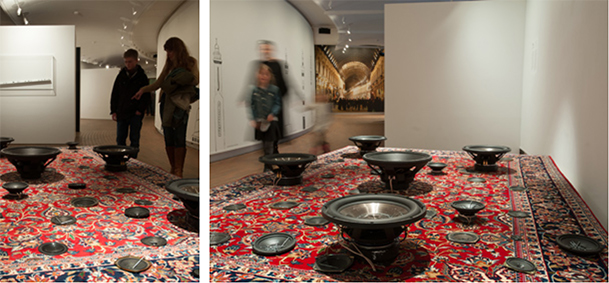
2011, 50cm x 336cm x 226cm, sound system, speakers carpets on a wooden structure.
Exhibition view of Arab Contemporary, Louisiana Museum of Modern art, 2014, Humblaek.
Courtesy of the artist and Jane Lombard, New York.
Ed. of 5 + 1 A.P.
 Video Video
''A large Oriental rug is spread out over a palette and loud- speakers protrude from the surface, projecting the sounds of protest.
Nails have been added to some of the concave speakers and rattle around, adding a tinny, violent edge to the already piercing sounds.
Noise was an important part of the uprisings, which began with people coming together to make their grievances heard.''
Caroline Rossiter, June 2010
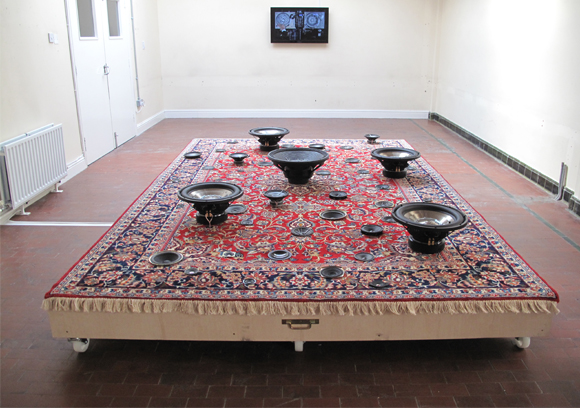
Oriental Accident
Exhibition view of Terrible Beauty, Dublin Contemporary 2011, Dublin.
Courtesy of the artist.
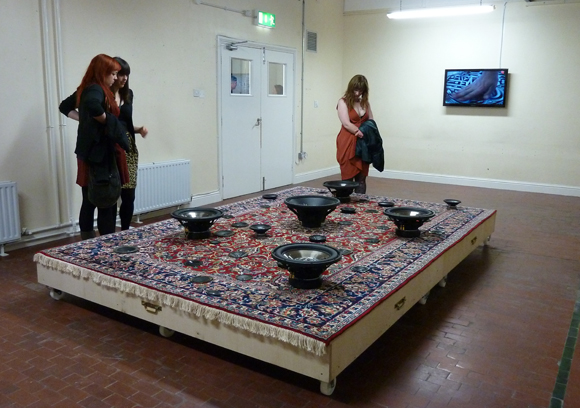
Oriental Accident
Exhibition view of Terrible Beauty, Dublin Contemporary 2011, Dublin.
Courtesy of the artist.

Oriental Accident
Exhibition view of Oriental Accident, Lombard-Freid Projects, 2012, New York.
Courtesy of the artist.
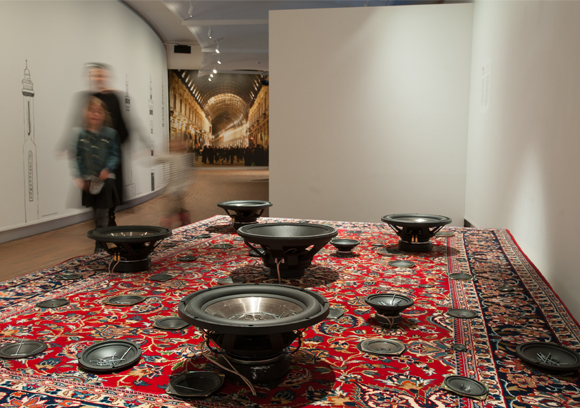
Oriental Accident
Exhibition view of Arab Contemporary, Louisiana Museum of Modern art, 2014, Humblaek.
Courtesy of the artist.
|
|
|
|
|
| This work was part of Dublin Contemporary 2011, Dublin, 2011.
Des cris retentissent. Des voix mêlées d'applaudissements d'une foule nombreuse résonnent. Une clameur envahit l'espace qui incite le spectateur à en chercher la nature et l'origine et le conduit vers un curieux dispositif sonore. "Oriental Accident", installation plastique et acoustique, est une improbable réunion d'éléments à la variété déroutante : un tapis persan déroulé sur une structure en bois à roulettes est équipé de hauts parleurs de tailles et de bandes passantes différentes. Certains d'entre eux diffusent les enregistrements de manifestations qui se sont tenues sur les places publiques pendant Le Printemps Arabe et reproduisent le formidable concert de voix humaines. De manière non moins étonnante, il semble que des hauts parleurs de très basses fréquences émettent également un signal. Si l'oreille du spectateur n'est pas équipée pour percevoir les infrabasses, de petits clous métalliques disposés dans le châssis des hauts parleurs permettent d'en observer visuellement l'activité en s'entrechoquant à chaque soubresaut de la membrane.
Oriental Accident évoque les mouvements révolutionnaires du Printemps Arabe qui se sont déroulés dans de nombreux pays et traite de leurs causes et de leurs suites immédiates. Son dispositif, invitation à comprendre, analyse les conditions matérielles, politiques, sociales et linguistiques des mouvements populaires ainsi que leur nature et leur déroulement. Il offre une représentation d'une situation géopolitique inédite et complexe, imprévue et incertaine. Mounir Fatmi réalise avec Oriental Accident une cartographie du hasard et de l'incertitude et interroge une nouvelle fois les moyens de l'art pour traiter des grands bouleversements de l'histoire et pour saisir les éléments contemporains et volatiles de l'histoire en train d'advenir. En ce sens, Oriental Accident est une tentative pour mettre au point une technique de reproduction de l'événement historique au même titre, par exemple, qu'un haut parleur est une technique de reproduction sonore.
Cette généalogie de l'imprévu prend en compte les paramètres essentiels qui la compose et multiplie les techniques de relevé des données. Allant de la collecte de données directement observables, à l'appréhension de ce qui échappe aux sens et qui relève éventuellement de l'inaudible (un brouhaha), de l'invisible (un courant électrique) ou de l'inécoutable (une infrabasse), Oriental Accident tente de tenir compte de la complexité de la situation : multiplicité des nations et des individus, des générations, des époques et des idéologies, mobilité soudaine du contexte social traditionnel et circulation des discours et des idées. Cette multiplicité est-elle le signal de troubles et de tensions contradictoires insolubles ou celui d'une activité qui vise à la garantir et à la faire évoluer ? La mobilité est-elle agitation insensée et dangereuse ou se prépare t'elle à se transformer en mouvements libres ?
Bricolage au charme désuet que cette installation finalement, ou prémisses d'une invention révolutionnaire ? Mounir Fatmi laisse certaines questions en suspens et propose une esthétique de l'imprévisible et de l'imperceptible qui incite le spectateur à mobiliser tous ses sens et son intellect pour comprendre les événements qui se déroulent sous ses yeux et agir.
Studio Fatmi, Février 2017.
|
|
Screams resonate. Voices and applause emanating from a large crowd can be heard. A clamor that fills the space pushes the viewer to look for its nature and origin, which can be found in a curious sound apparatus. Oriental Accident, a plastic and acoustic installation, is an improbable combination of disconcertingly varied elements: a Persian rug is rolled out over a wooden structure with wheels equipped with loudspeakers of various sizes emitting various sounds. Some of them play recordings of protests held on public squares during the Arab Spring, reproducing an amazing concert of human voices. Just as surprisingly, other loudspeakers seems to be emitting very low frequency signals. If the viewer’s ear isn’t able to perceive these infra-bass sounds, small metallic nails placed in the frame of the loudspeakers visually transcribe them by bouncing about with every vibration of the membranes.
Oriental Accident evokes the revolutionary movements of the Arab Spring that took place in a series of countries and addresses their causes and immediate results. Its composition is an invitation to try and understand; it analyzes the material, political, social and linguistic conditions of these popular movements as well as their nature and how they rolled out. It also offers a representation of an unprecedented, complex, unforeseen and uncertain geopolitical situation. With Oriental Accident, Mounir Fatmi creates a map of happenstance and uncertainty and questions once again the ways in which art can address great historical shifts and grasp the contemporary and volatile elements of history in the making. In that sense, Oriental Accident is an attempt to develop a reproduction technique for an historical event, just like a loudspeaker can reproduce sound, for instance.
This genealogy of unexpectedness takes into account the essential parameters that compose it and multiplies data recording techniques. From directly observable information to apprehending what eludes the senses and may be akin to the inaudible (the hubbub of voices), the invisible (an electrical current) or the unhearable (infra-basses), Oriental Accident tries to account for the complexity of the situation with its multiplicity of nations and individuals, generations, eras and ideologies, the sudden motility of the traditional social context and the circulation of discourses and ideas. Does such a multiplicity herald contradictory and unsolvable troubles and tensions, or on the contrary an activity that aims to guarantee it and help it evolve? Is motility a senseless and dangerous agitation or is it preparing to transform itself into free movements?
In the end, is this installation a quaint and haphazard assemblage or the beginnings of a revolutionary invention? Mounir Fatmi leaves certain questions unanswered and offers an esthetic of the unpredictable and imperceptible that pushes the viewer to call upon all his senses and his intellect in order to understand the events unrolling before his eyes and take action.
Studio Fatmi, February 2017. |
|
|
|